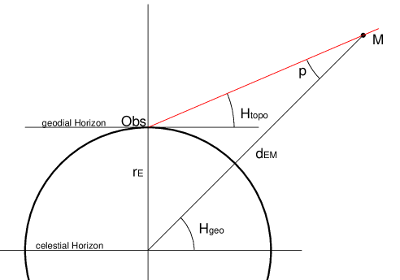Notes on the Calculation of Geocentric ParallaxIn astronomy, parallax is the effect that a celestial object is seen in slightly different directions when observed from two widely separated locations. The visible effect of parallax is that objects closer to the observer (e.g. the Moon) will "move" against the background of far-away objects (e.g. the stars), when the observer changes his location. The astronomical position calculations for the Nautical Almanac are based on a reference point, which is located in the center of the Earth. Positions of celestial objects obtained in this way are called geocentric positions since they refer to the center of the Earth. A navigator observing celestial objects, however is located on the surface of the Earth and may see close objects in a slightly different direction as compared to an imaginary "geocentric observer".
The sides of the oblique triangle are:
From this, the parallax angle p for a measured Altitude Htopo can be derived (using the identity: sin(90°+Ho) = cos(Ho):
The parallactic angle p is zero if the observed Altitude is 90°. In this case the observer is in the Geographic Position (GP) of the celestial object and sees the object directly overhead (in the Zenith). Another special case occurs, when the observer sees the celestial body on the horizon. In this case, the topographic Altitude Htopo is 0° and the parallactic angle obtains it's maximum value called "horizontal parallax" (HP):
Sextant Correction for ParallaxIn order to be able to compare an observed Altitude Htopo to a calculated Altitude Hgeo, the parallax correction p has to be taken into account. This is shown in the the following identities:
For the different celestial bodies, the parallactic angle p
depends on their size and their distance to the Earth.
These values are combined in the value of the horizontal parallax (HP),
which can be obtained from the daily pages of the Nautical Almanac. The Moon however, may have a parallactic angle of up to 1°.
The effect of this parallax, is that two observers located far apart on the surface of the Earth,
will see the Moon at quite different positions against the celestial background and correction
for parallax is required. The Moon is a special case also when it comes to correcting the
effect of the semi-diameter (SD). In order to obtain the correct situation as pictured
above, the correction for semi-diameter must be performed before doing the parallax correction.
However, the semi-diameter measured in the location of the observer may be slighly higher that the
geocentric semi-diamater recorded in the Nautical Almanac. This effect is called
"augmentation-of-the-Moon" and may be as large as 0.3 minutes-of-arc for high Altitudes. |
| Cover << Sail Away << Celestial Navigation << Correction Tables << . | last updated: 18-Jan-2019 |
